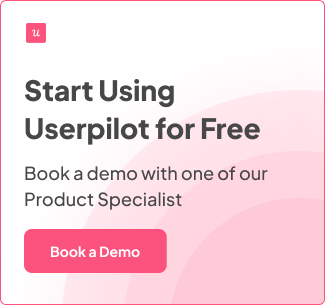UserGuiding vs Userlane: Which is Better for No-Code Growth?
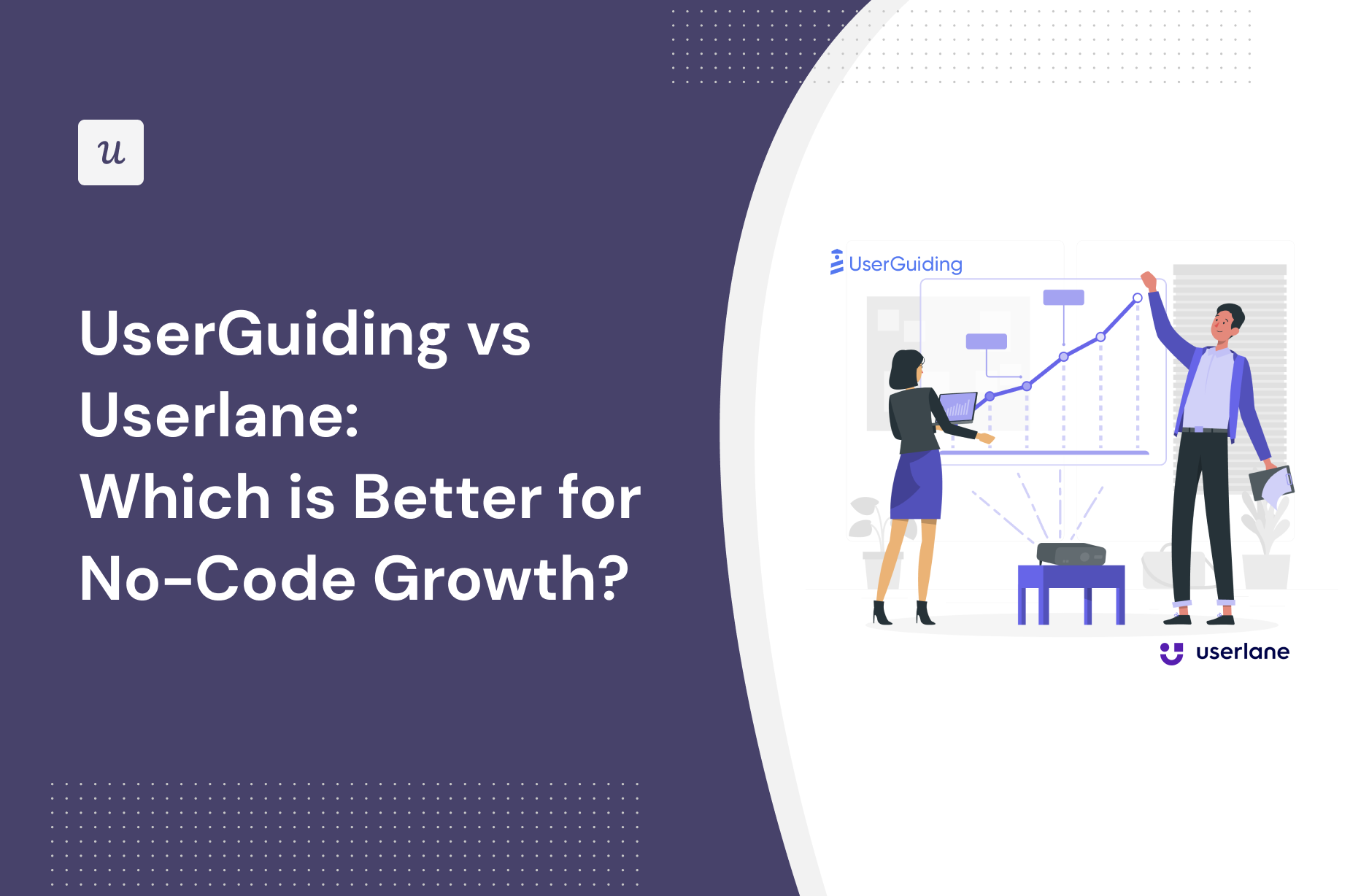
Is UserGuiding or Userlane the best tool for no-code growth? And is there a better in-app onboarding software that would better fit your needs?
With so many alternatives on review sites, it’s a bit tricky to really choose one.
You need to consider your priorities and what functionality you’ll need from the tool to get the job done. Then there’s also the price that needs to match your budget. Right?
In this post, we’ll discuss exactly that – what the perfect tool for no-code growth should deliver and which will be the best choice for your company’s needs.
Let’s dive in!
TL;DR
- Let’s explore how UserGuiding, and Userlane compare when it comes to enabling SaaS no-code growth.
- UserGuiding is a no-code product adoption tool that lets users create in-app walkthroughs, guides, and checklists. The solution makes it possible for teams to onboard, engage, and retain users without needing coding skills to create these in-app experiences.
- Userlane is a no-code digital adoption platform used to measure how employees use applications, identify areas for improvement, and offer real-time guidance directly within any application.
- If you’re looking for a better option for no-code growth, Userpilot exceeds both functionality and value for money compared to other tools on the list.
- Userpilot is a product growth platform that drives user activation, feature adoption, and expansion revenue. It also helps product teams collect user feedback, streamline onboarding, and gather actionable insights from analytics.
- Get a Userpilot demo and drive your product growth code-free.
What is no-code growth?
No-code growth is a method of achieving product-led growth (using your own product as a lever and revenue growth channel) without coding, using no-code tools.
It essentially allows people like product managers, product marketing managers or marketers (who may not necessarily have a background in engineering) to create e.g. in-app onboarding experiences, optimize signup and onboarding flows etc. in order to achieve higher conversion rates, user activation rates – and in the long run – drive retention.
No-code movement in general empowers non-programmers to create software elements using a graphical user interface, instead of writing code. According to no-code advocates, technology should enable and facilitate creation, not act as a barrier.
Must have features for no-code growth tools
Before deciding which no-code growth tool deserves your try, you should have a basic understanding of what features you should be looking for in “the one.”
Although the exact features you need will differ based on factors such as the size of your company, your business strategy, and your goals, here are the most crucial features you should look for:
- Truly “no code” – make sure the no code growth tool you pick really allows you to build and style robust and native-looking in-app experiences without coding. You will be surprised how many tools require the knowledge of CSS to publish decent-looking onboarding flows.
- Make sure the tool you choose has all the basic UI patterns available – e.g., checklists, modals, tooltips, banners, and hotspots. This will allow you to create all the product-led growth experiences you may need.
- Targeting the experiences to the right user segments is extremely important for your PLG plays to be successful. Make sure your no-code growth tool offers advanced segmentation capabilities, so you can build customer segments based on product usage, in-app behavior, feedback, and user persona to craft hyper-personalized messages and trigger them at the right time.
- On that note – real-time, event-based triggering is an important feature of a product growth platform that only a few solutions on the market currently offer. Being able to respond to your users’ actions in real-time can be critical to pushing them toward those precious conversion points.
- Finally, product analytics is another “must-have” that a good no-code growth platform should provide. You should be able to monitor your users’ behavior with it, the engagement with your PLG in-app experiences, and how they contribute towards improving your metrics.
- The right code-free PLG tool should also offer integrations with other tools so you can add them to your stack and get better insights on your data under one roof.
UserGuiding for no-code growth
UserGuiding is a no-code product adoption tool that lets users create in-app walkthroughs, guides, and checklists. The solution makes it possible for teams to onboard, engage, and retain users without needing coding skills to create these in-app experiences.
All in all, UserGuiding is a pretty flexible solution that can improve the onboarding process, boost user engagement, and increase customer retention.
No-code product tours in UserGuiding
UserGuiding does have the features necessary for creating basic product tours, but the no-code implementation will depend on how complex you need these onboarding flows to be. Full integration of the UserGuiding solution does require some updates to your coding.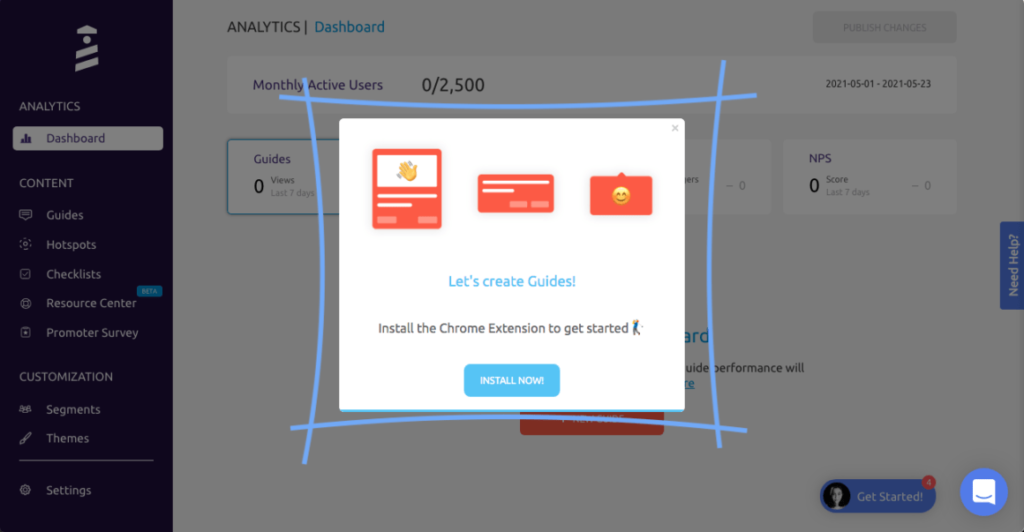
Here are a few UserGuiding features you can use in your product tours:
- Guides: The UserGuiding Chrome extension lets you add multi-step guides to any page of your website with elements like modals, tooltips, and input fields, then preview the flow before publishing.
- Checklists: Onboarding checklists give users a sense of progress as they move through your product tours (but UserGuiding only lets you have two active at a time unless you upgrade to the Professional plan or higher).
- Hotspots: A more subtle way to highlight specific features, buttons, or elements during product tours would be to use UserGuiding’s hotspot UI pattern.
Product growth analysis in UserGuiding
Product growth is the end goal of all onboarding and adoption efforts. UserGuiding may not have the most advanced analytics capabilities (especially in comparison to competitors like Userpilot or Pendo), but it does have data filters and content engagement metrics that you can monitor.
Here are the UserGuiding features and settings you can use to extract insights from growth analytics:
- Logic Filters: UserGuiding’s and/or filters help you narrow down results (such as data or users) based on which conditions are met. This makes it possible to conduct growth analysis for different segments, cohorts, or users with similar attributes in order to spot patterns.

- Content Engagement: While UserGuiding lacks more detailed growth metrics, it does track engagement for all materials created within the platform. This lets you monitor the view count and completion rate for guides, checklists, or other UserGuiding material currently in use.

- Analytics Limitations: One of the biggest limitations of UserGuiding’s analytics capabilities is the fact that you can’t view data in real-time. All analytics are only calculated and refreshed once every 10 minutes, so you’ll need to wait for dashboards to be updated before checking metrics.
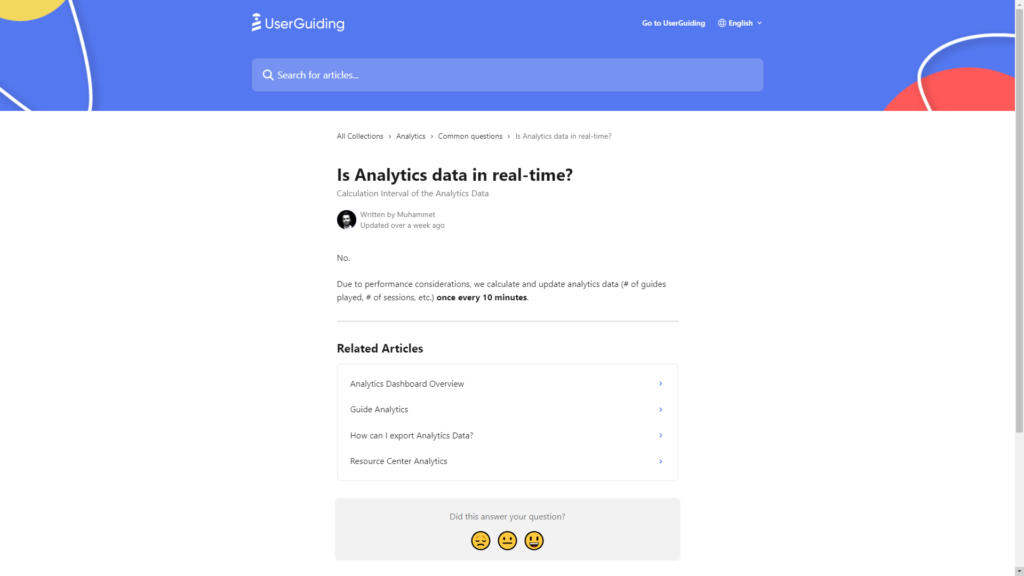
Userlane for no-code growth
Userlane is a no-code digital adoption platform used to measure how employees use applications, identify areas for improvement, and offer real-time guidance directly within any application.
In addition, it allows you to get a real-time view of digital transformation progress in your organization. You can now delve deeper into user behaviors across different applications and analyze engagement levels so you can optimize user experiences.
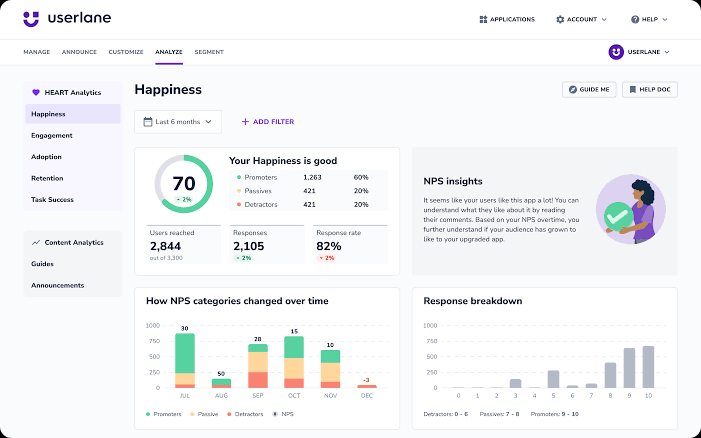
No-code product tours in Userlane
Userlane is primarily designed to create interactive product walkthroughs with simplicity. For companies looking to integrate a basic onboarding experience without coding complexities, Userlane’s no-code platform is an ideal choice.
It provides a seamless solution for businesses to create in-app interactive content. Rather than requiring extensive coding and development effort, Userlane enables organizations to craft intuitive product tours rapidly.
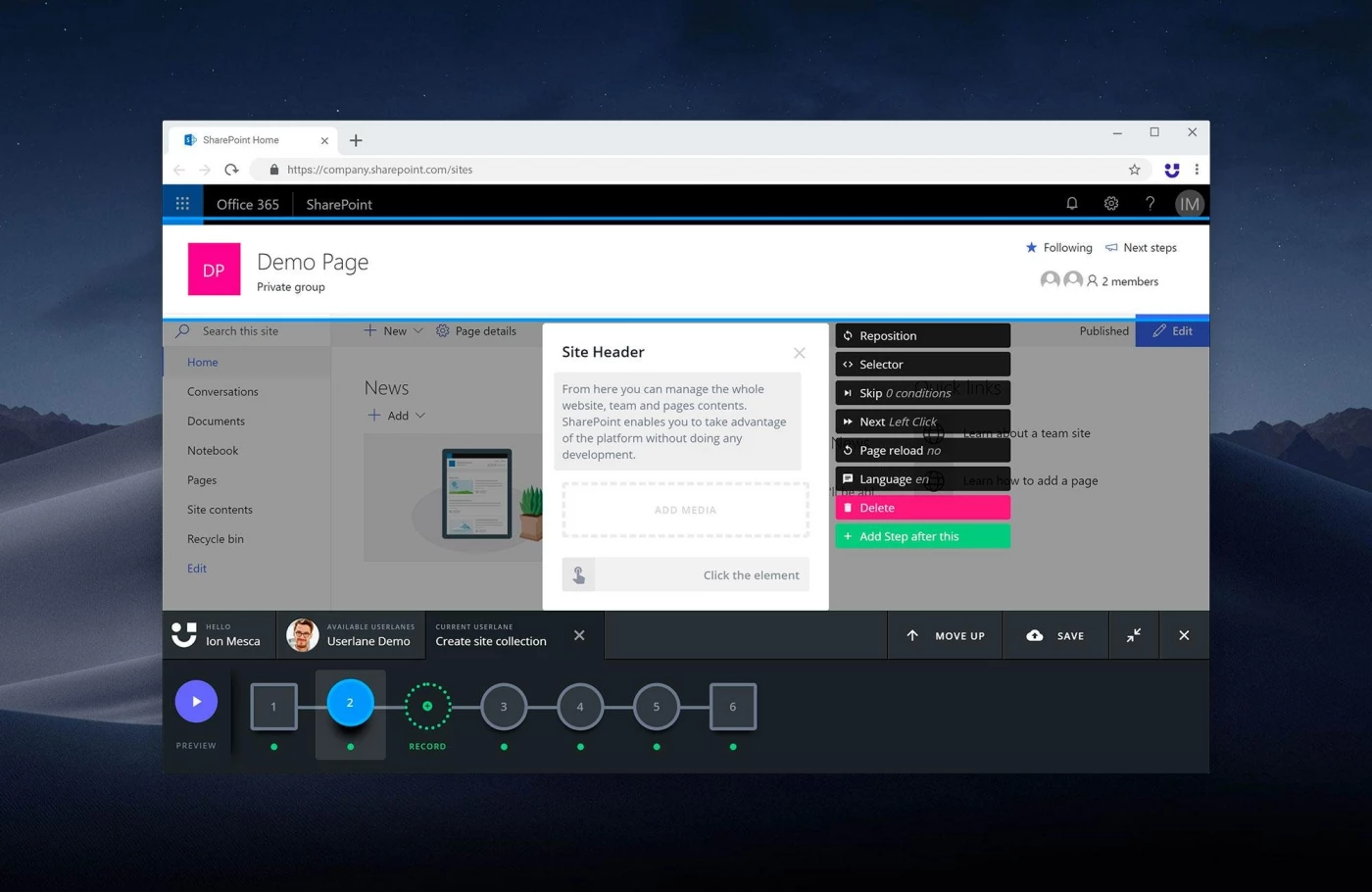
Here’s a breakdown of the features of Userlane for no-code product tours:
- Interactive Step-by-Step Guidance: Userlane offers a visual editor that allows creators to design step-by-step instructions directly within the application interface. These guides provide users with a hands-on approach to learning, leading them through real-time processes. This ensures that users aren’t just reading instructions but are actively engaged in performing tasks.
- Analytics and Performance Insights Without Code: Beyond just crafting the tours, Userlane’s no-code platform provides businesses with valuable insights into user engagement. Organizations can monitor the effectiveness of their onboarding content, pinpoint areas of improvement, and optimize their guides—all through a user-friendly, code-free dashboard.
- Personalized User Segmentation with No-Code Customization: Userlane’s no-code capabilities enable businesses to tailor tours based on user roles, preferences, or behaviors without diving into complex programming.
Product growth analysis in Userlane
Product growth analysis is a key ingredient to increasing product adoption.
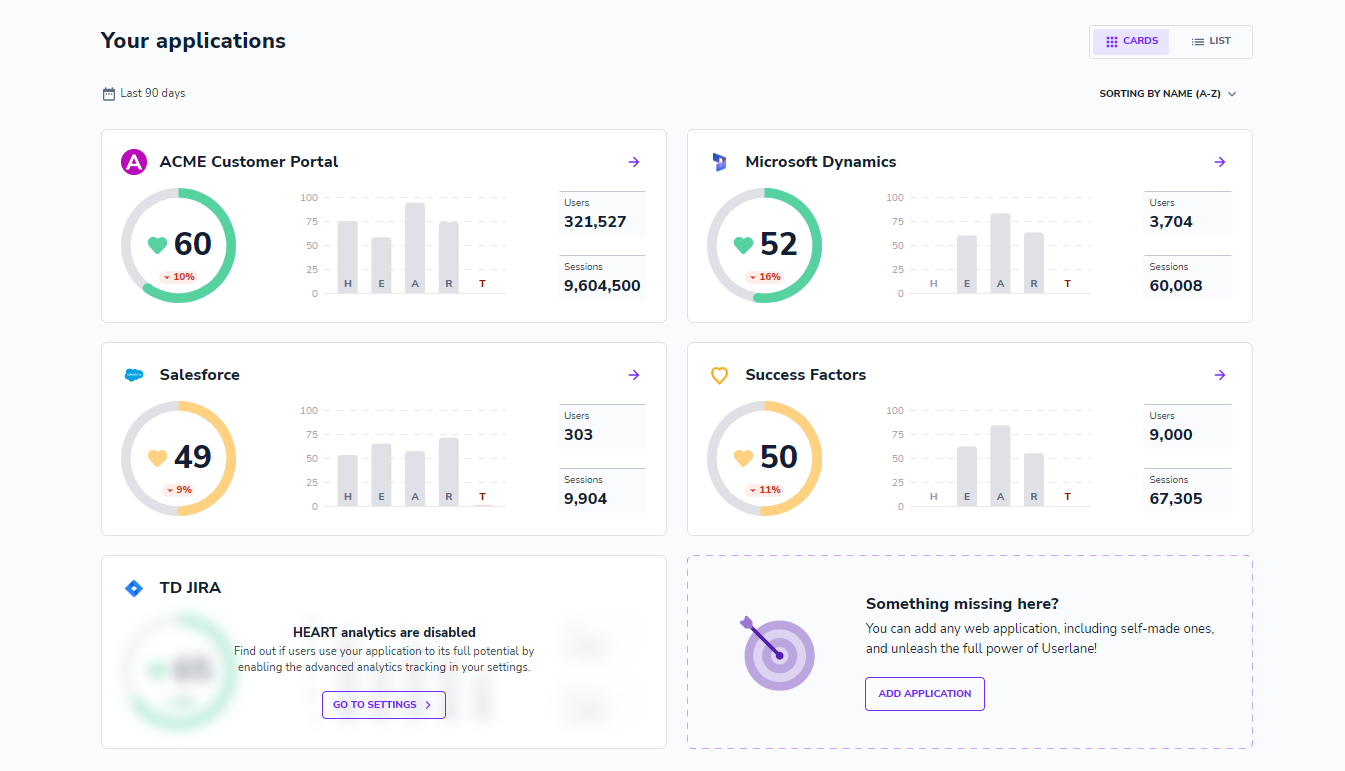 Userlane’s HEART analytics is a standardized model to monitor value realization across enterprise applications.
Userlane’s HEART analytics is a standardized model to monitor value realization across enterprise applications.
Based on user interaction metrics and usage patterns, a single score indicates the current value realization for each application based on five core value drivers:
- Happiness: Users are satisfied with the application and are likely to recommend it. Understand how users feel about your app with the Happiness tool. You can monitor this using a Net Promoter Score (NPS) or surveys. The NPS measures user loyalty by asking about the likelihood of users recommending your application.
- Engagement: Users interact with the application actively. Engagement shows your user’s involvement by tracking how many engaged (meaningful) sessions they had and how much time they spent in your application or on a certain page.
- Adoption: Users come to the application and utilize it broadly. With the Adoption Score, you can see how many users arrived, and you can track this number compared to the ratio of the expected number of users.
- Retention: Users keep coming back to the application. The retention score is a measure of how many of your users are coming back to your application.
- Task Success: Users accomplish their tasks. The Task Success Rate will help you measure user interaction with tasks and interesting elements to be aware if users complete tasks or interact with important features easily and efficiently.
UserGuiding vs Userlane: Which one fits your budget?
Understanding the cost implications is paramount when selecting the right solution for no-code growth needs, so here’s a detailed pricing comparison of UserGuiding and Userlane.
Pricing of UserGuiding
UserGuiding has three plans to choose from, targeted towards a range of business sizes from startup to enterprise.
Here are UserGuiding’s specific pricing details:
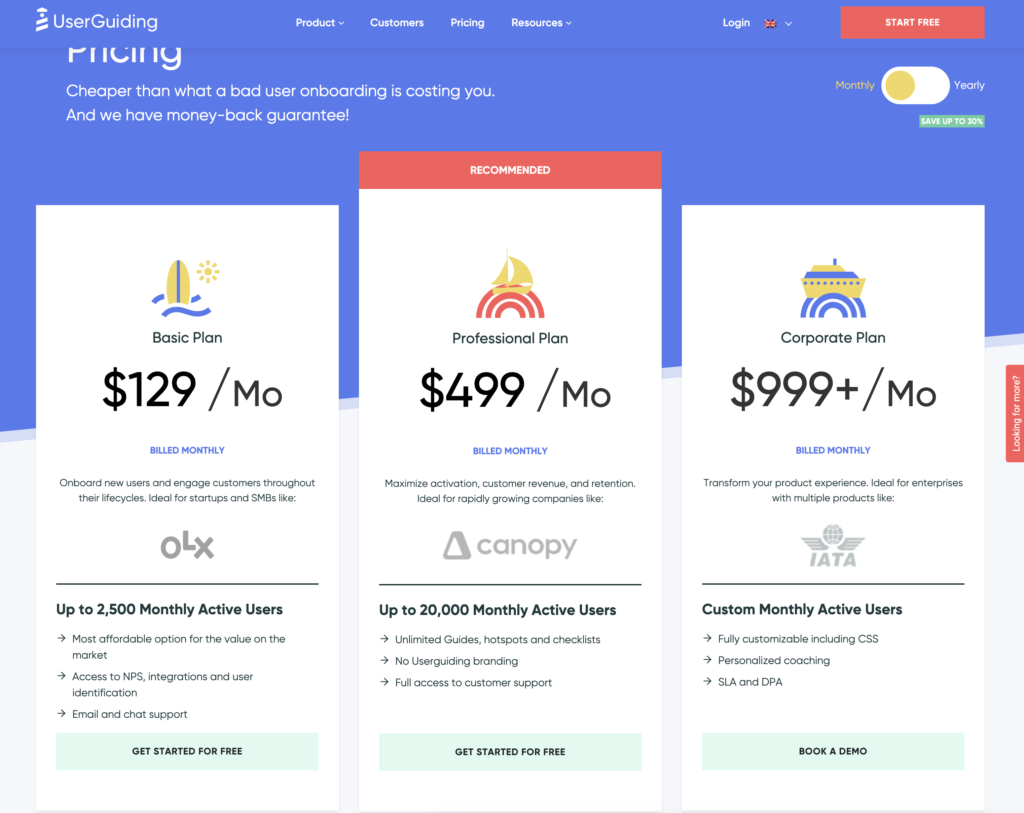
- Basic: Costing $129/month, the Basic plan is targeted towards startups and SMBs. The Basic plan is quite limited as it caps your account at one active survey, two active checklists, and no more than 2,500 MAUs. Features include:
- Access to user identification features.
- Integrations with Google Analytics, HubSpot, Intercom, and more.
- Email and chat support.
- Customizable theme (only one).
- Professional: The Professional plan costs almost 4x as much as the Basic tier at $499/month. That said, it significantly increases capacity to 20,000 MAUs and improves the quality of customer support you’ll receive. Features include:
- Removal of UserGuiding branding.
- Language localization.
- Full customer support access.
- Five team member seats.
- Five customizable themes.
- Unlimited guides and checklists.
- Corporate: Subscriptions on the Corporate plan start at $999/month. Of course, this higher price does come with its fair share of enterprise perks. Features include:
- Service Level Agreement (SLA) + Data Processing Agreement (DPA).
- Up to 10 active surveys.
- Custom MAU capacity based on your needs.
- Unlimited team member seats.
- Unlimited customizable themes.
All monthly plans are marked down by 30% when customers choose to bill annually.
Pricing of Userlane
Userlane’s pricing plan is structured in a customizable pattern. This means you need to get a custom quote to know the plan that fits your brand’s purpose based on the level of your SaaS and the number of acquired customers.
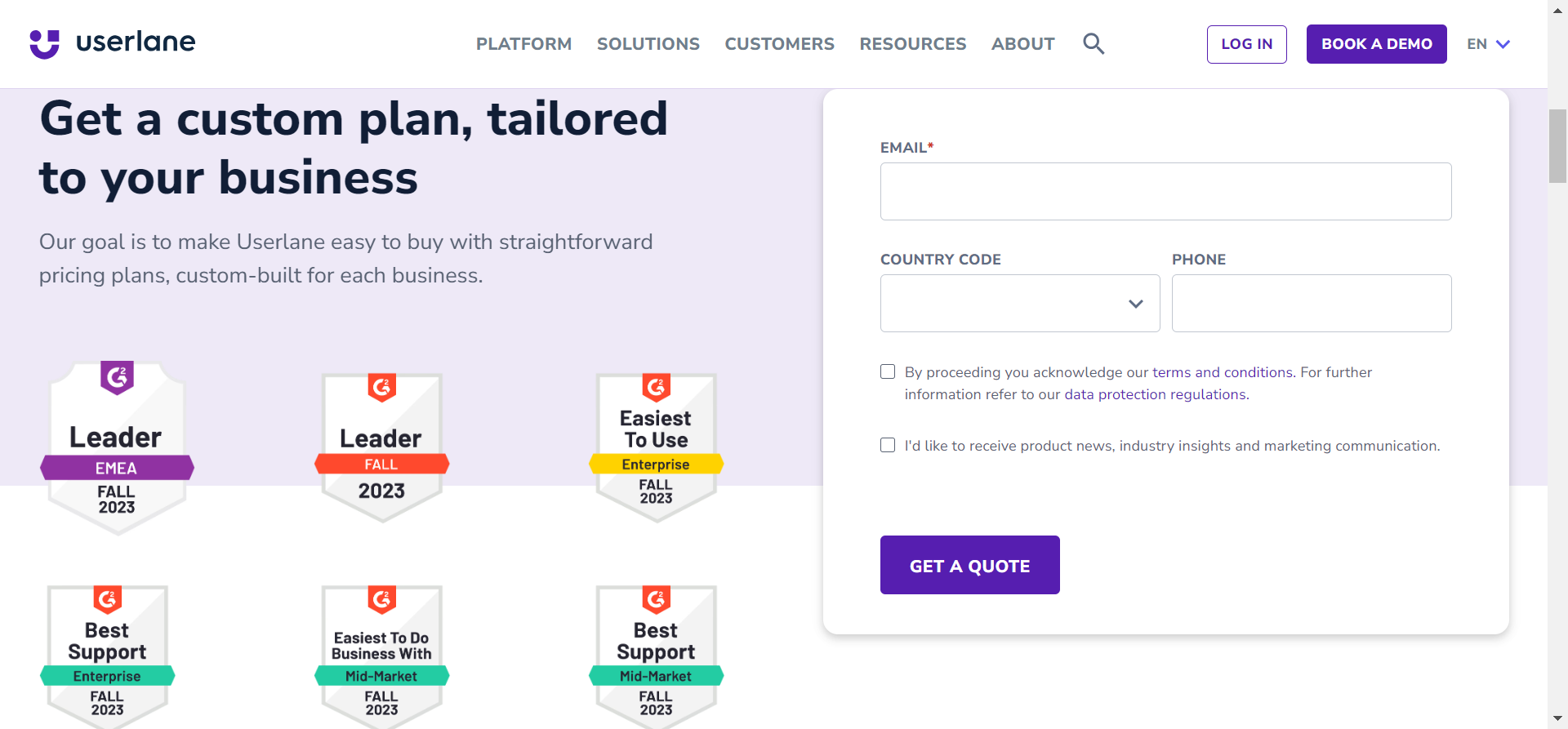
Pros and cons of UserGuiding
You might need an alternative solution to UserGuiding if you fall into any of the following use cases:
- Advanced analytics: If you’re looking for a product adoption platform with full-suite native analytics then you’ll likely need to look at platforms like Userpilot or Appcues that are better suited to your needs.
- Create fully interactive product tours: While UserGuiding excels in creating in-app experiences and user guides, it may not offer the breadth of tools needed to fully support a comprehensive product adoption strategy.
- Build segments completely code-free: As segmentation features aren’t very intuitive and may require additional help from a developer.
Pros of UserGuiding
UserGuiding has quite a few benefits as a product adoption solution, particularly for early-stage SaaS companies that need an easy-to-use starter tool for their small (but growing) team of product developers or marketers. Let’s look at some of the pros that UserGuiding has to offer:
- Chrome extension – UserGuiding utilizes a no-code Chrome extension.
- Survey template gallery – UserGuiding lets you choose from six survey templates or create your own survey from scratch.
- Analytics dashboard – users can see their monthly active users (MAUs) for the month, monitor the number of views their guides are getting, and see how many interactions checklists or resource centers have had in the past week from the UserGuiding homepage.
- Custom themes – granular theme customization and color selection.
- Easy onboarding – onboarding checklist walks you through key steps, such as how to get the UserGuiding Chrome extension and create your first guide.
Cons of UserGuiding
While there are quite a few benefits to using UserGuiding, there are three significant drawbacks to note:
- Dashboard customization – you can’t edit your home dashboard or choose which analytics you want to see.
- Pricing jumps – upgrading from Basic (2,500 MAUs) to Professional (20,000 MAUs) increases your subscription cost by more than 4x.
- Manual localization – UserGuiding doesn’t have AI-powered localization, so you’ll need to manually download, translate, and upload every CSV when attempting to localize content for your product.
- HubSpot integration – the UserGuiding-HubSpot integration is only a one-way integration which limits its functionality and prevents you from setting up two-way data synchronization between both platforms.
- Limited analytics – the analytics dashboard only shows you data for onboarding materials created with UserGuiding and even those analytics are quite limited as surveys only show you total responses rather than letting you select a date range.
- Survey limit – you can only have one active survey on the Basic plan which is disappointing considering UserGuiding costs over $1,000 annually (whereas Userpilot lets you create unlimited surveys and collect up to 250 responses per month on the cheapest plan).
Pros and cons of Userlane
While Userlane is undoubtedly powerful, certain scenarios might necessitate exploring alternatives.
- Extensive Third-party Integrations: While Userlane offers some key integrations if your business heavily relies on a diverse range of third-party tools and you need a seamless, in-depth integration for all of them, you might want to explore platforms like Pendo or Mixpanel that offer broader integration ecosystems.
- Budget Constraints: While Userlane offers a plethora of features suitable for established enterprises or growing companies, it might be beyond the reach of early-stage startups with limited funds. If you’re on a strict budget and looking for a more affordable solution, platforms like UserGuiding, Intercom, or Intro.js might be more aligned with your financial constraints.
- Complex Customization Needs: If your platform requires highly specialized or intricate onboarding experiences that go beyond standard walkthroughs and tooltips, you might find Userlane’s customization options a bit restrictive. In such cases, tools like WalkMe or Appcues, known for their deep customization capabilities, might be a better fit.
Pros of Userlane
Higher productivity, less support effort, and happier users are what Userlane is created for. From a vast spectrum of capabilities to elegantly crafted UI elements that cater to any walkthrough, regardless of its level of customization, Userlane stands out as a robust platform to bolster user engagement and product familiarization.
Let’s dive into the pros of using Userlane:
- Streamlined no-code interface: Userlane boasts a user-friendly dashboard, enabling even those with no coding background to easily design and implement onboarding flows.
- Product adoption analytics: Get a real-time view of digital transformation progress in your organization. Delve deeper into user behaviors across different applications and analyze engagement levels so you can optimize user experiences.
- Dynamic user walkthroughs: Craft compelling and interactive walkthroughs that intuitively guide users through your software, ensuring they grasp every essential feature.
- Versatile in-app communication tools: Whether tooltips, banners, or pop-up modals, Userlane offers many tools to engage users directly within your platform. With Userlane’s customer onboarding solution, you can tailor communications for different user segments, guiding them through the tasks and processes they will most likely need help with.
- Seamless third-party integrations: Integrate Userlane with various analytics tools, CRM platforms, and other essential software to ensure a harmonious workflow and data sharing.
- Granular audience segmentation: Understand your users and their needs better by segmenting them based on behavior, user type, or other customizable metrics. This ensures that your messaging and tours are always relevant and timely.
- Optimized A/B testing capabilities: Refine your onboarding and in-app messaging by A/B testing different approaches, enabling you to continually enhance user experience based on concrete data.
- Thoughtful pacing with walkthrough rate limiting: Ensure users aren’t too quickly bombarded with too much information. With Userlane’s rate limiting, you can pace the introduction of new features or tasks, striking a balance between informing and overwhelming.
Cons of Userlane
As with any tool, weighing its strengths and weaknesses is essential. Here are the notable drawbacks of adopting Userlane:
- Visual Customization Restrictions: One of Userlane’s apparent setbacks lies in its restricted visual customization capabilities. If you have an eye for aesthetic and unique branding elements might find the platform limiting. The lack of diverse templates and somewhat rigid design elements could impede brands from truly reflecting their identity.
- Analytical Ambiguities: In the age of data-driven decision-making, Userlane’s analytical powers — or the lack thereof — stand out. While it offers basic insights, those looking for a deep dive into granular user behavior, funnel analysis, heatmaps, and more might need to bridge the gap with external integrations.
- Integration Quandaries: Speaking of integrations, Userlane might not be the Swiss Army knife of connectivity that some businesses might be hoping for. While essentials like Zendesk, Google Analytics, Hubspot, and Salesforce are on the list, those yearning for a wider array of integration options might need to strategize around these limitations.
- Cost Considerations: Userlane’s pricing structure could be a roadblock, especially for startups and SMEs keen on budget constraints. The initial investment for Userlane might seem daunting, especially considering the added costs of potential integrations and the learning curve associated with maximizing the platform’s potential.
Userpilot – A better alternative for no-code growth
Userpilot is a product growth platform that drives user activation, feature adoption, and expansion revenue. It also helps product teams collect user feedback, streamline onboarding, and gather actionable insights from analytics.
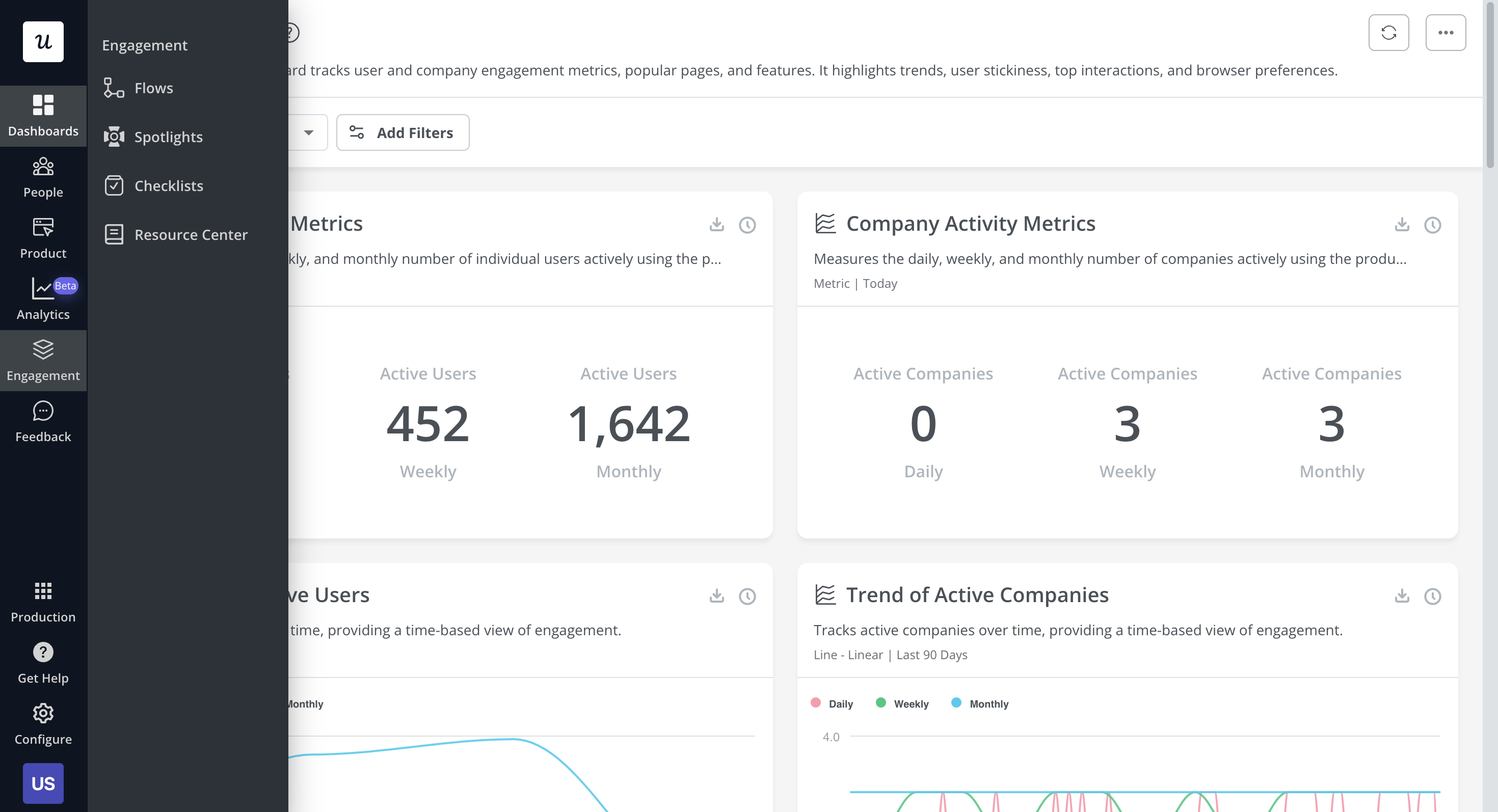
With Userpilot, you’ll be able to track both product usage and user behavior to get a holistic view of how customers use your product — which will guide future development, improve the user experience, and inform your growth efforts.
No-code product tours in Userpilot
Product tours are an effective way to show new users what a product can do and reduce the time-to-value (TTV) for them. Userpilot lets you build advanced product tours, set contextual triggers, and target specific audiences, all without writing a single line of code.
Here are the Userpilot features that you can use to build a product tour for your users:
- Flow builder: Userpilot’s no-code flow builder has a variety of UI patterns to choose from, such as modals, slideouts, tooltips, and driven actions. All UI patterns are available for use regardless of which Userpilot plan you’re on. All you need to do is install the Chrome extension.
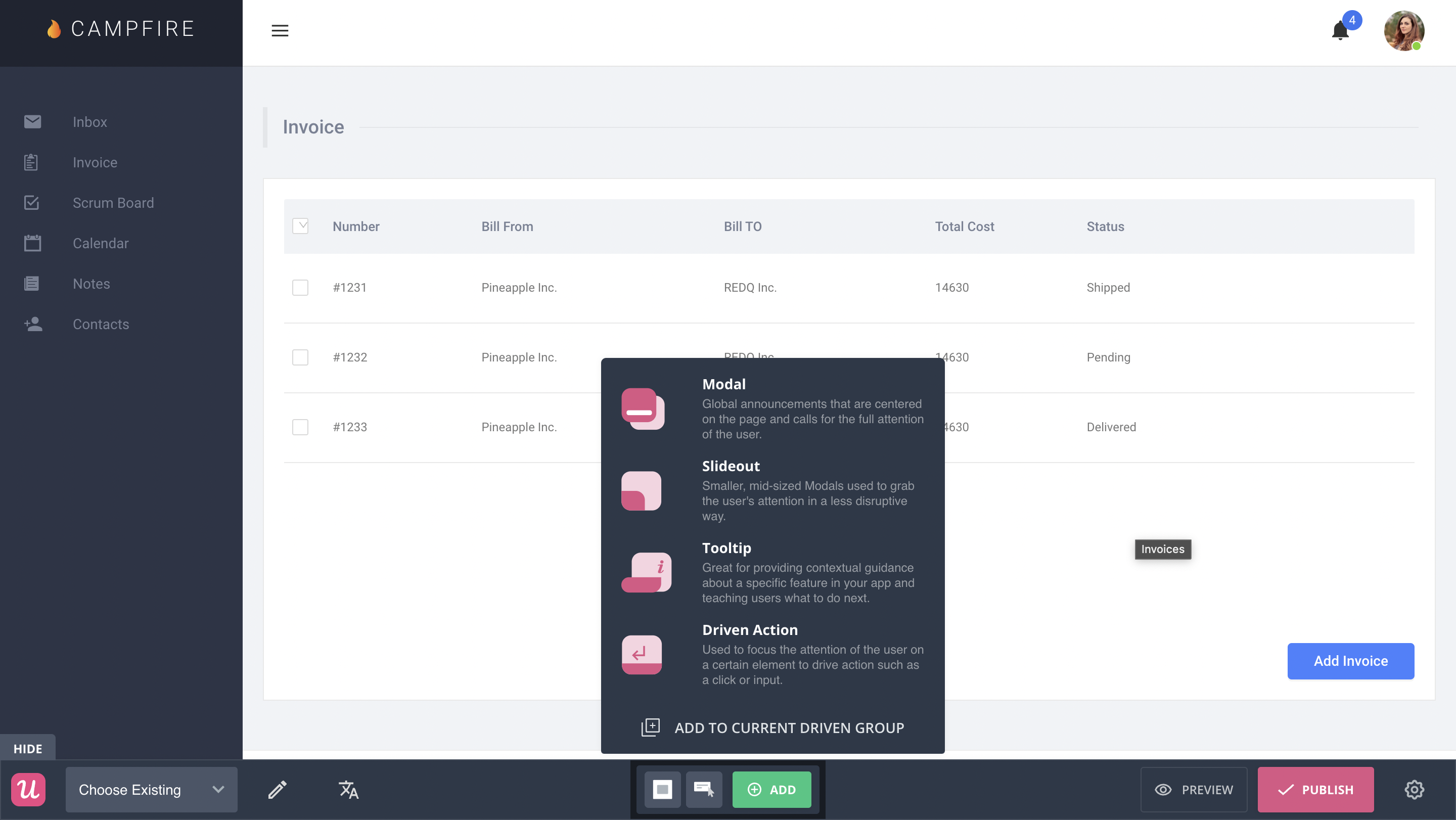
- Contextual triggers: Userpilot lets you set triggers for your flows to ensure that they appear at the most contextual moments. Flows could be triggered when users land on a specific page or when a tracked event occurs. There are also manual triggering options that you can tinker with.

- Audience targeting: Userpilot’s audience targeting setting lets you set the conditions needed for a flow to show up for a specific user. You can use these settings to create flows that target a specific segment or exclude certain users from seeing a flow if certain conditions are met.
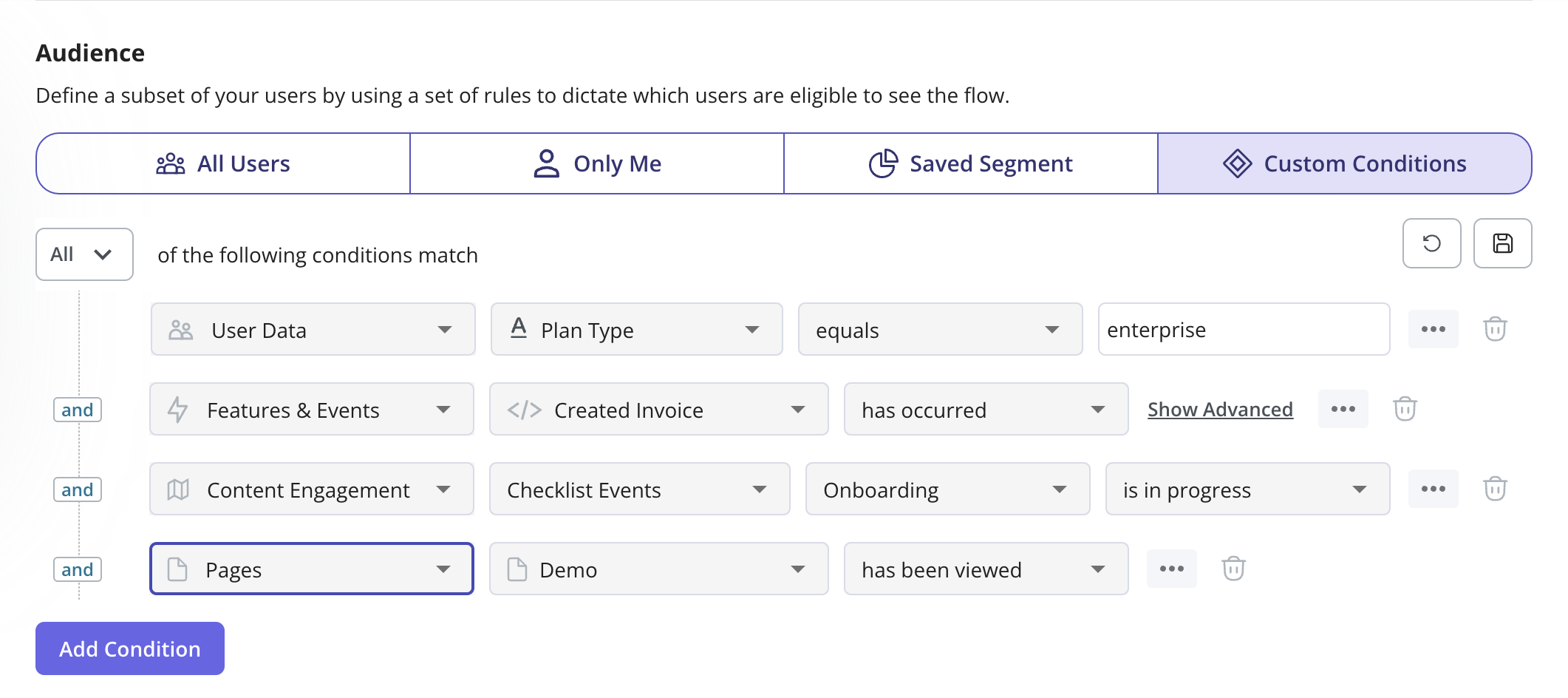
Product growth analysis in Userpilot
Tracking growth analytics is essential to gauge the overall trajectory of your product. Userpilot lets you track the completion rates for specific funnels, measure the number of users completing certain goals, and survey your customers to identify the issue whenever growth metrics trend downward. Here’s how Userpilot analytics can help you measure product growth:
- Dashboards: An easy way to keep track of your key product performance and user behavior metrics at a glance, without any technical setup required. There are 4 main dashboards available for your product growth analysis: Product usage, New users activation, Core feature engagement, and User retention.
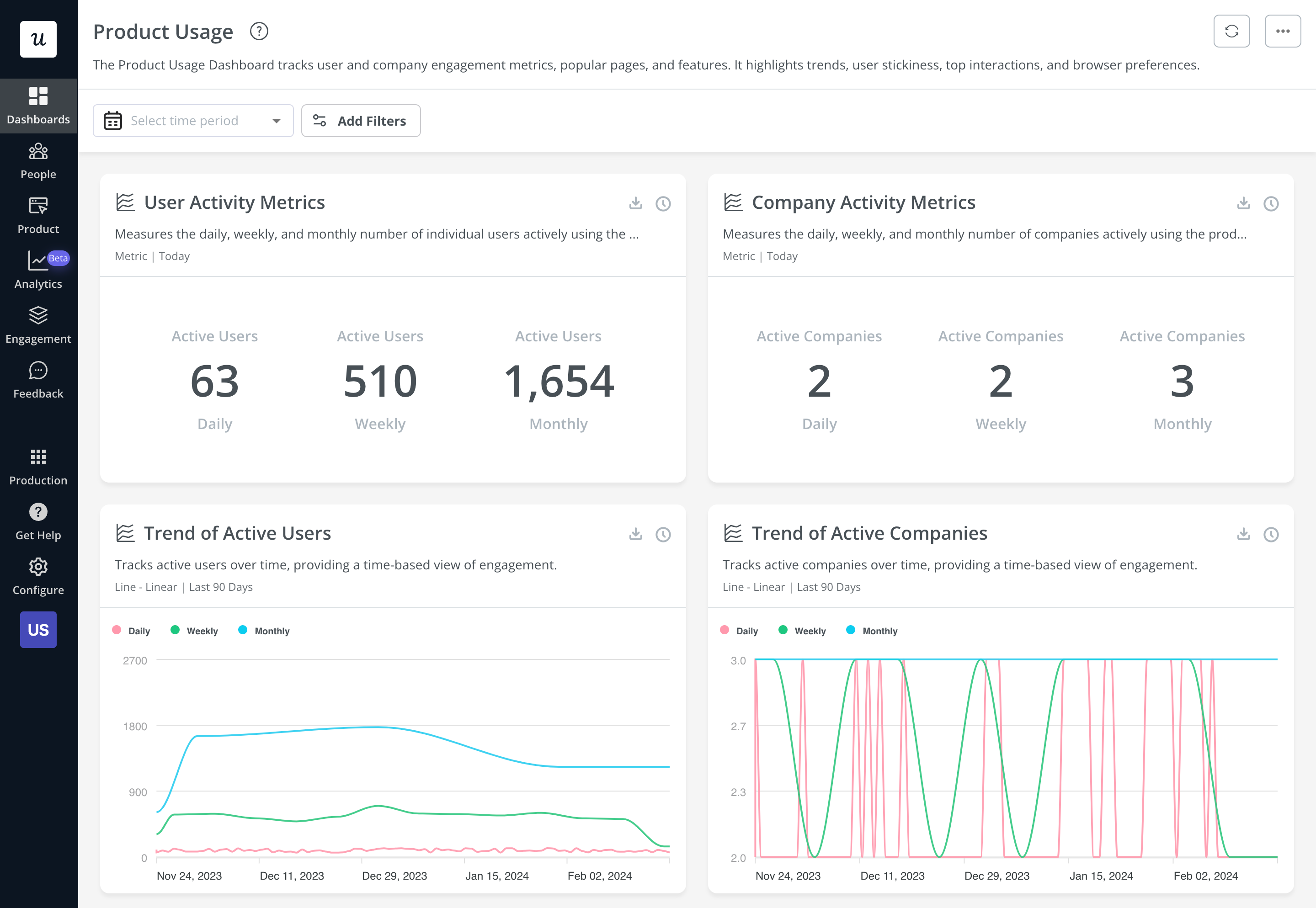
Product usage dashboard in Userpilot.
- Funnels: Userpilot’s funnel reports show you the number of users that enter a funnel and the percentage that completes each step. These visual charts can help you identify the roadblocks that are hindering user activation, causing churn, or sabotaging the efficacy of upsells.
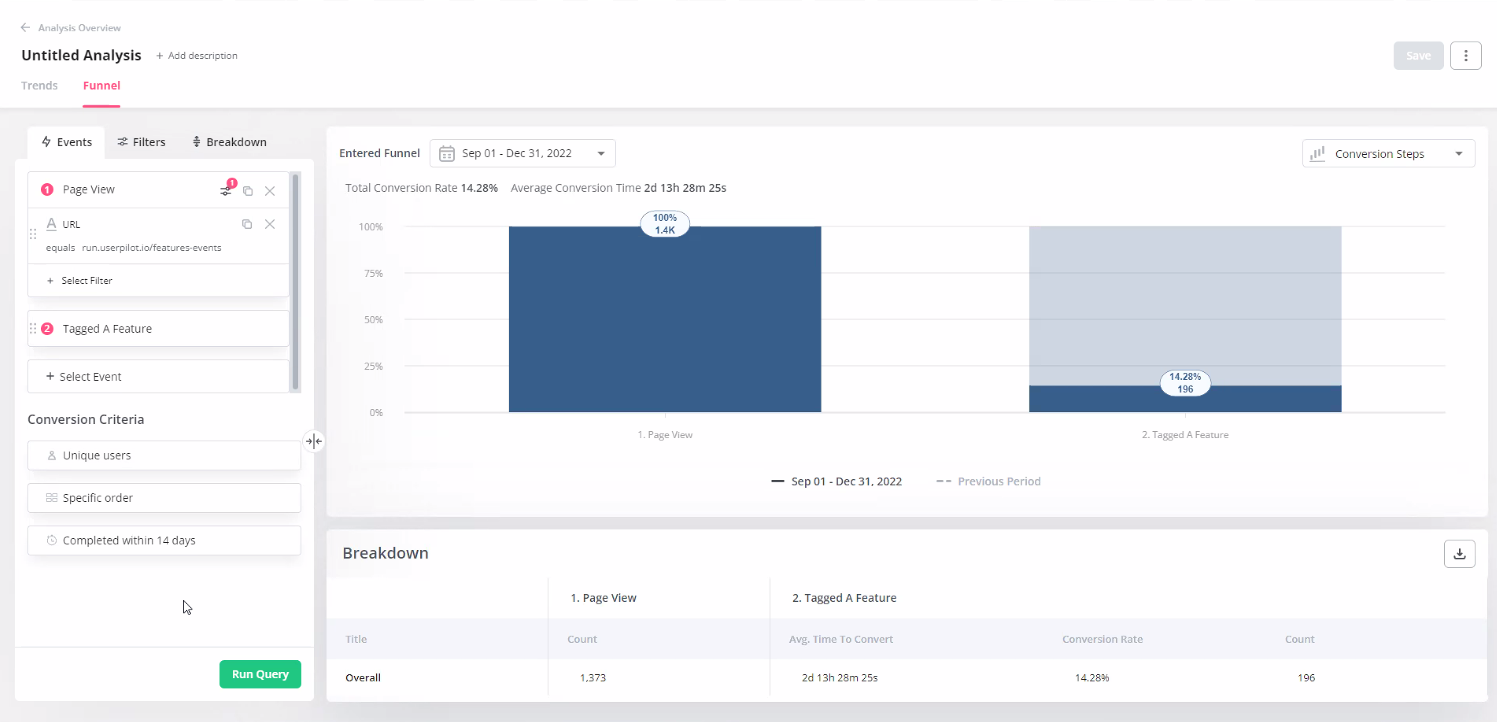
- Trends: Trend reports let you see how specific product changes impact retention metrics and monitor changes in active user counts over certain time periods. You can also create custom metrics, track events, or use the breakdown tab to perform a correlative retention analysis.
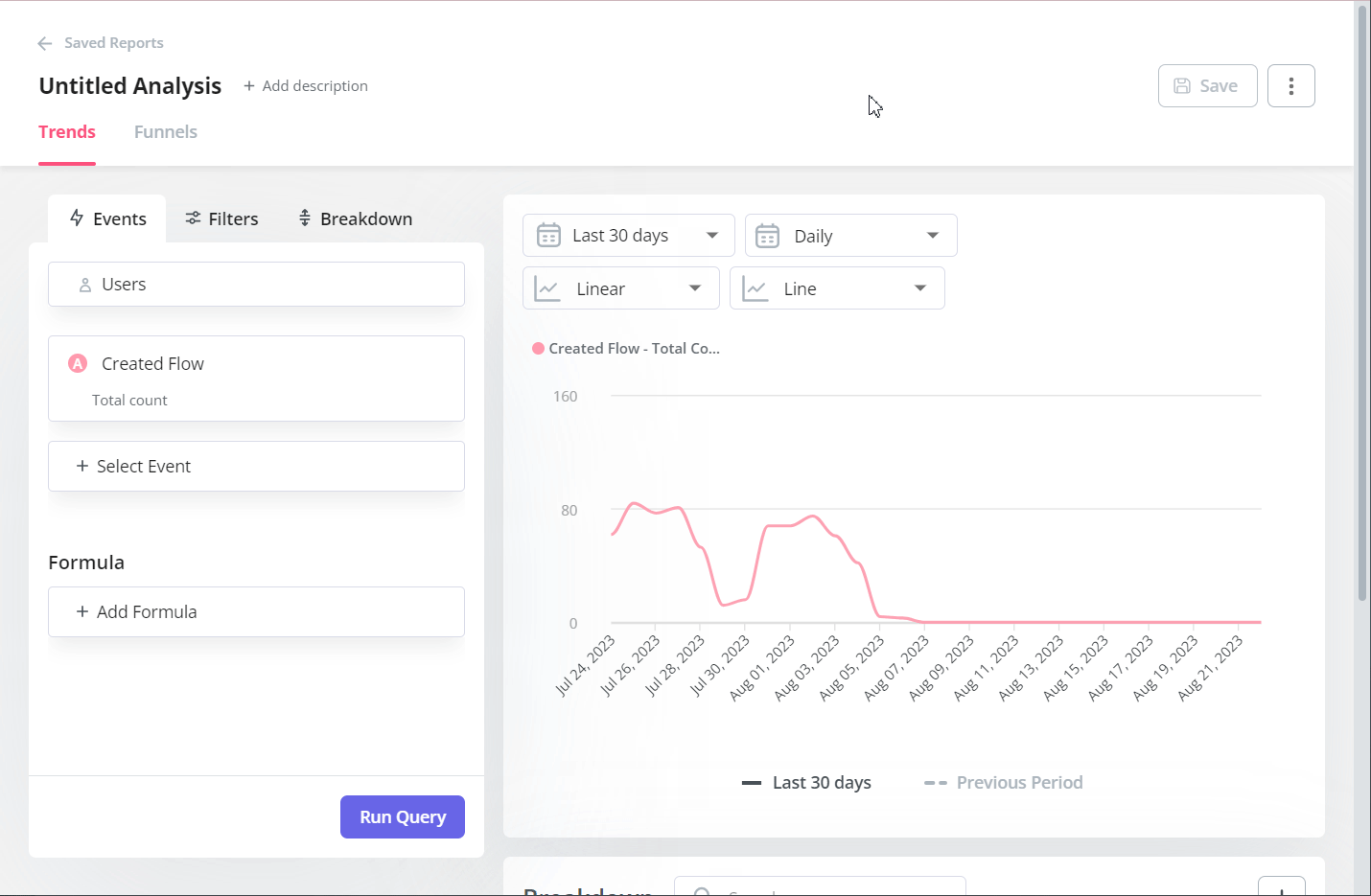
- Paths: It provides a detailed understanding of customer actions through a sequence of steps and helps pinpoint areas where customers tend to drop off – which may indicate frictions that hinder product growth.
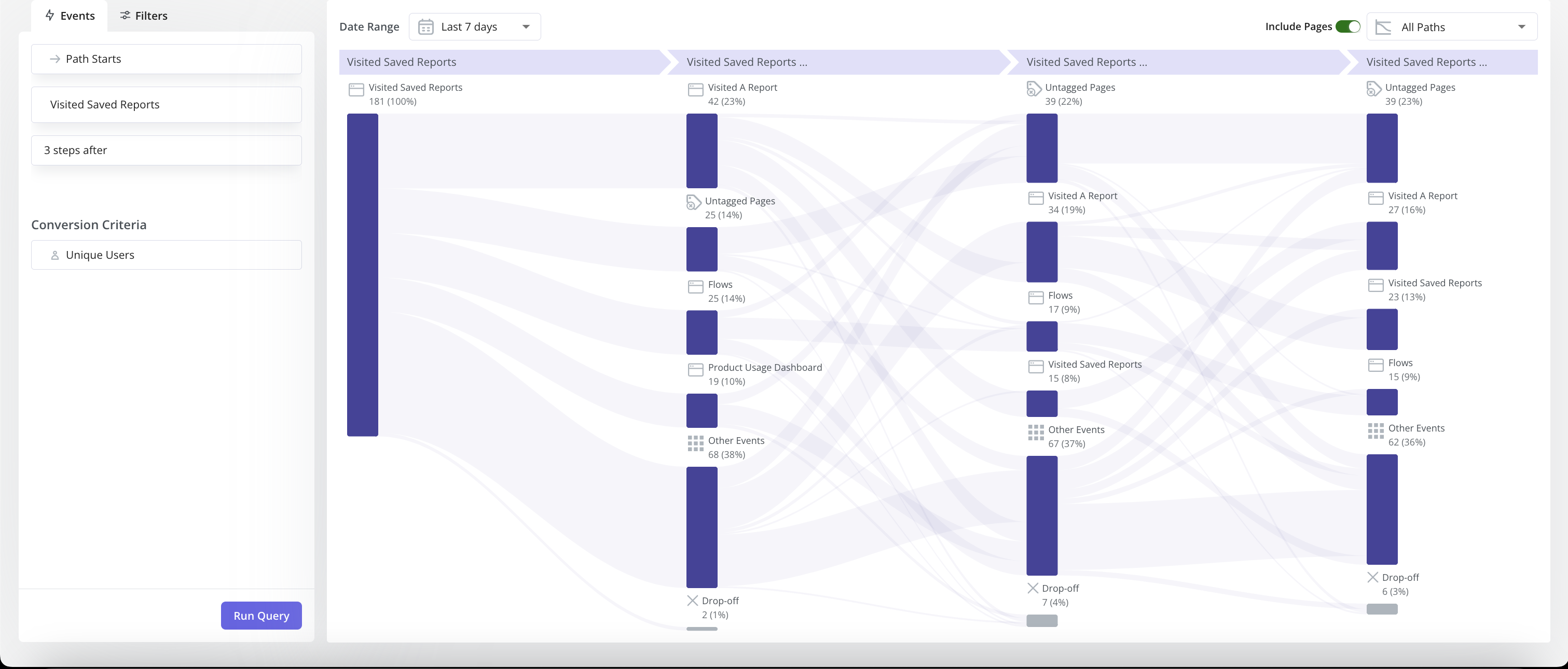
- Surveys: Userpilot’s survey builder has 14 survey templates that can help you find the root cause behind slowing growth rates. There are quantitative templates for collecting satisfaction metrics and qualitative surveys you can use to get user feedback on specific product areas or features.
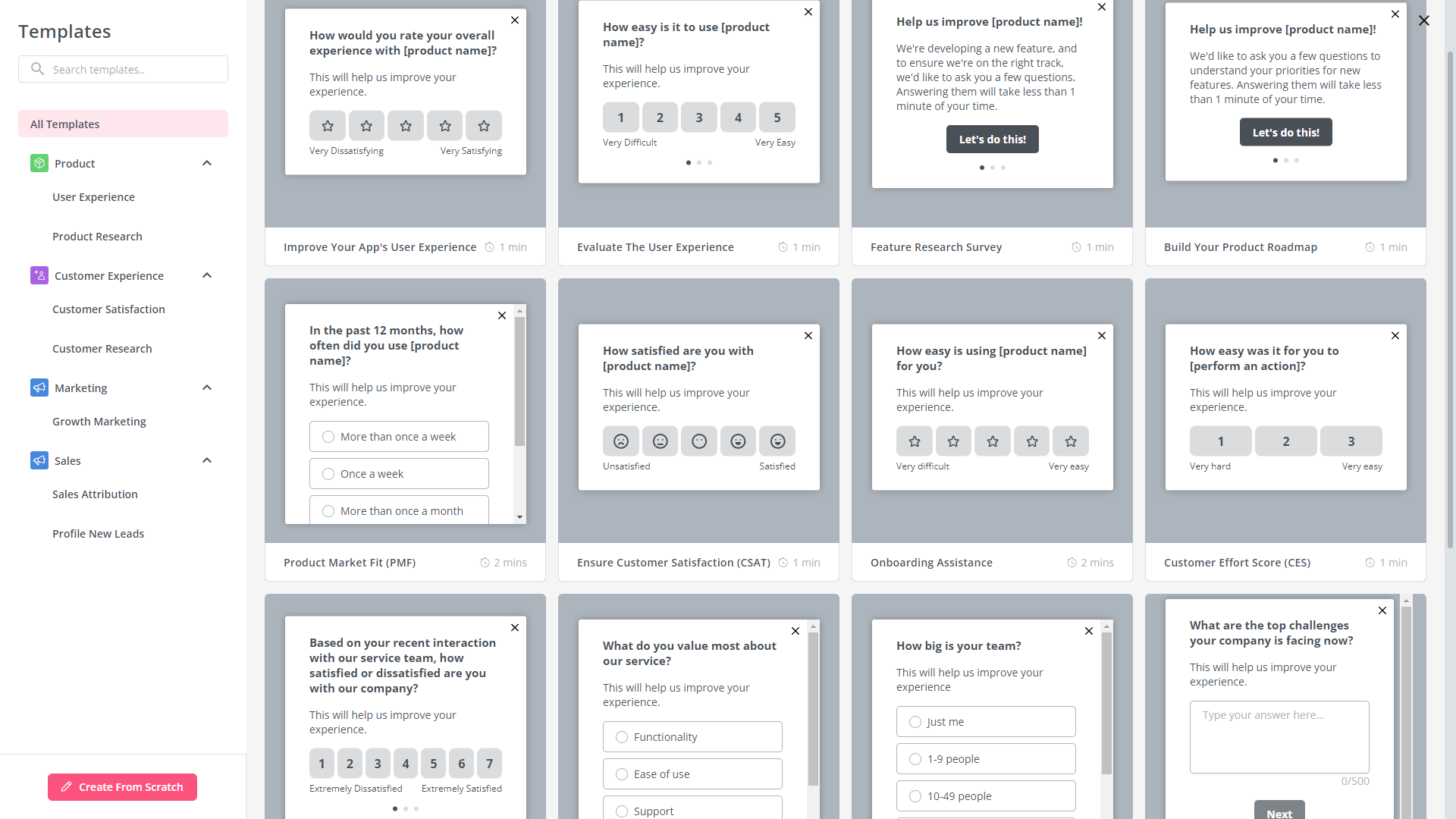
Pricing of Userpilot
Userpilot’s transparent pricing ranges from $249/month on the entry-level end to an Enterprise tier for larger companies.
Furthermore, Userpilot’s entry-level plan includes access to all UI patterns and should include everything that most mid-market SaaS businesses need to get started.
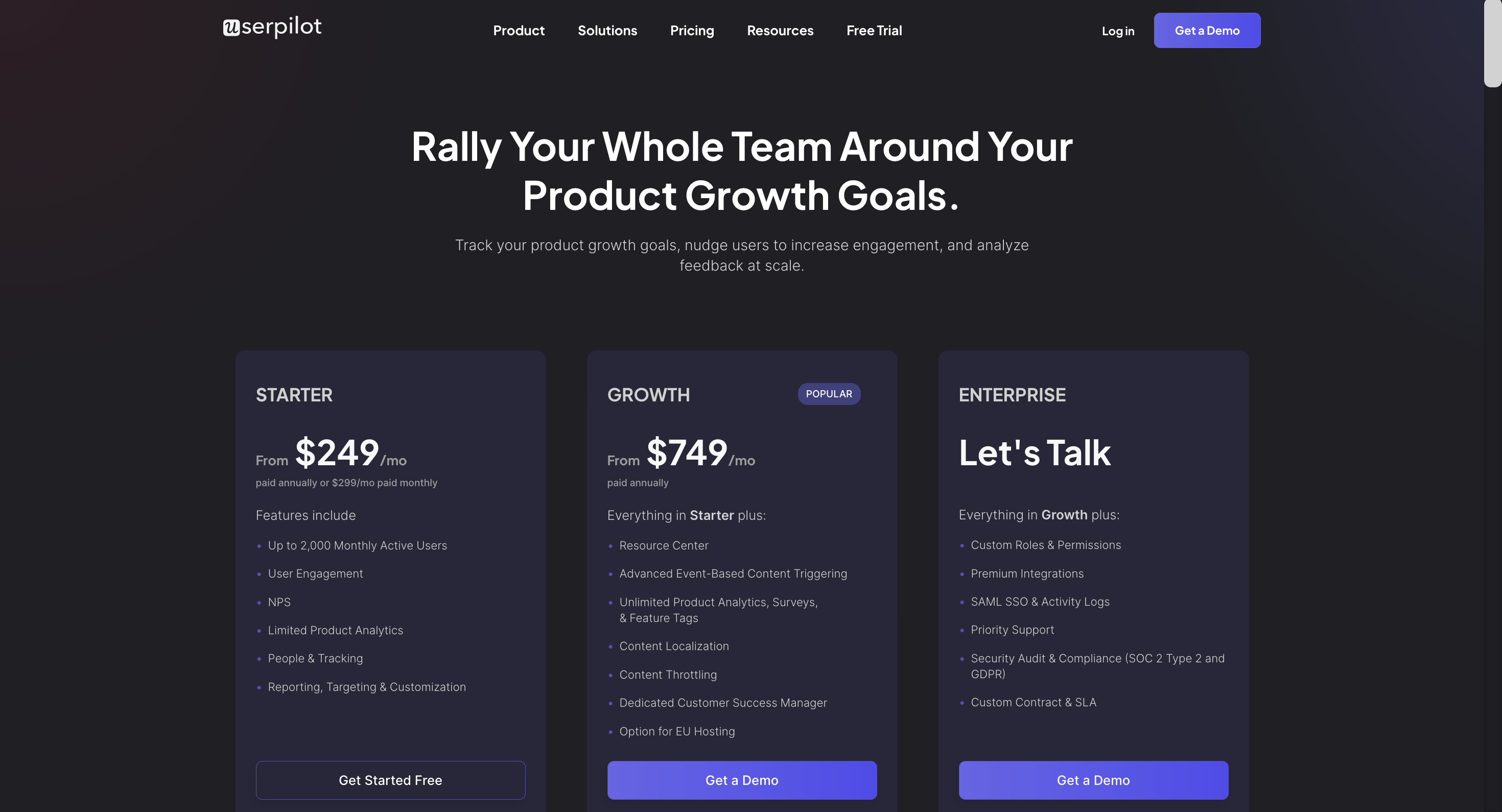
Userpilot has three paid plans to choose from:
- Starter: The entry-level Starter plan starts at $249/month and includes features like segmentation, product analytics, reporting, user engagement, NPS feedback, and customization.
- Growth: The Growth plan starts at $749/month and includes features like resource centers, advanced event-based triggers, unlimited feature tagging, AI-powered content localization, EU hosting options, and a dedicated customer success manager.
- Enterprise: The Enterprise plan uses custom pricing and includes all the features from Starter + Growth plus custom roles/permissions, access to premium integrations, priority support, custom contract, SLA, SAML SSO, activity logs, security audit, and compliance (SOC 2/GDPR).
What do users say about Userpilot?
Most users laud Userpilot for its versatile feature set, ease of use, and responsive support team:
I recently had the pleasure of using Userpilot, and I must say it exceeded all my expectations. As a product manager, I’m always on the lookout for tools that can enhance user onboarding and improve overall user experience. Userpilot not only delivered on these fronts but also went above and beyond with its impressive new features, unparalleled ease of use, and truly exceptional customer support.
What truly sets Userpilot apart is its outstanding customer support. Throughout my journey with Userpilot, the support team has been responsive, knowledgeable, and genuinely dedicated to helping me succeed. Whenever I had a question or encountered an issue, their support team was always there to assist promptly, going above and beyond to ensure my concerns were addressed effectively.
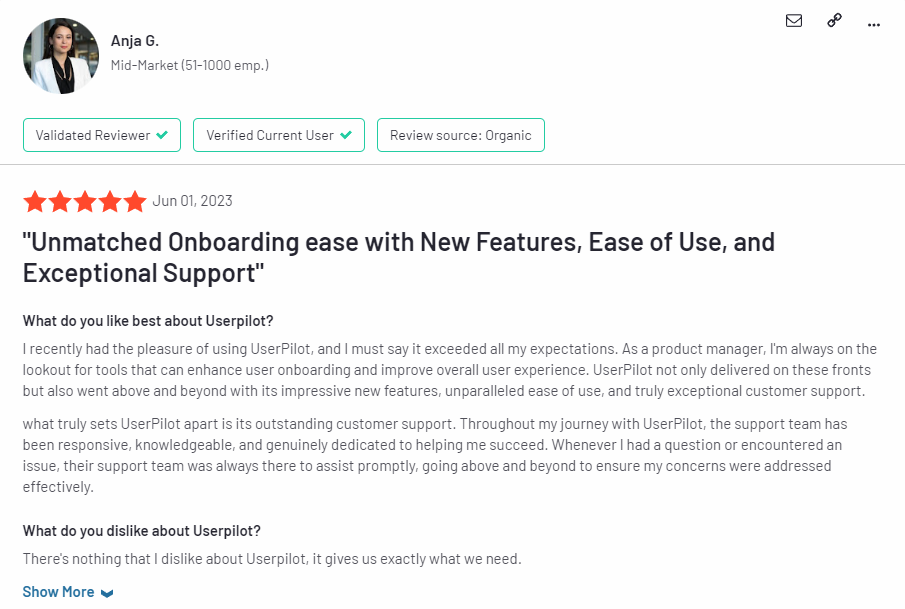
Source: G2.
Of course, other users are also kind enough to share constructive criticism regarding specific features like event tracking filters:
“The filtration while analyzing specific events is a little confusing. Understanding of custom properties and data management configuration could have been more organised.”
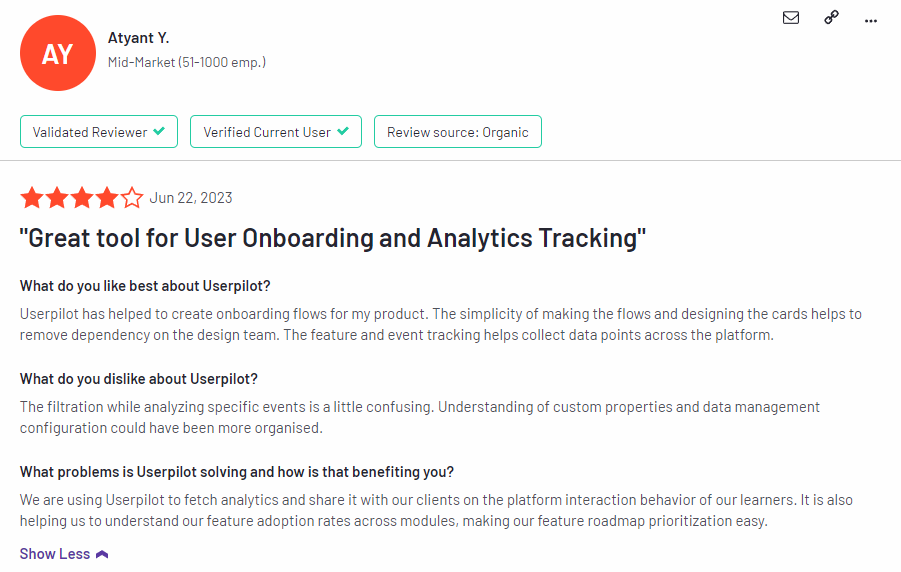
Source: G2.
Conclusion
This is the end of our thorough comparison between UserGuiding and Userlane. You should be able to make a confident decision by now. If you’re looking for a solid tool for no-code growth that promises great value for money, give Userpilot a go. Book a demo today.

